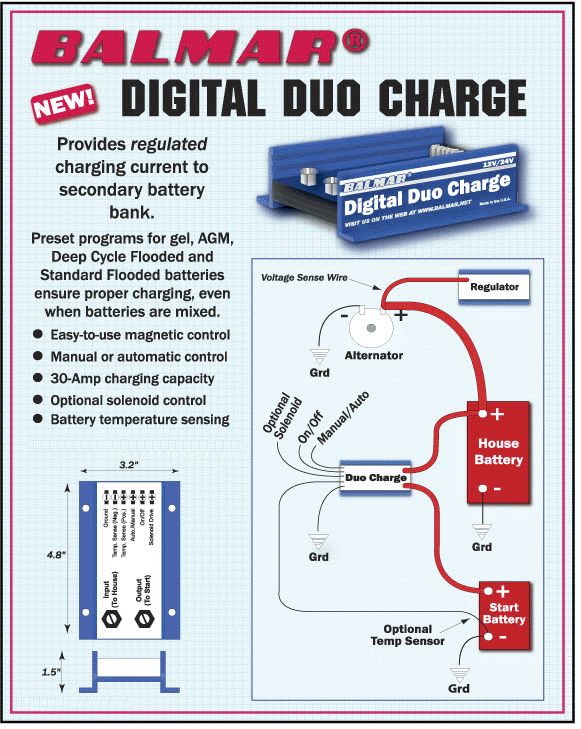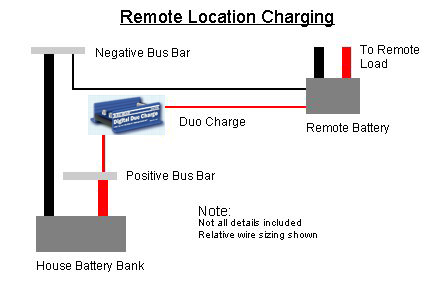

Duo Charge |
|
Below is a diagram showing a schematic of how the revolutionary Duo Charge functions. There is
no other product on the market that allows for the correct charging of two independent battery
banks. Also, on the right below, an example is shown how a remote battery (such as one for a windlass
or thruster) may be maintained (charged without requiring large wire runs) if the location is a distance
away from the charging source.
The Duo Charge is installed between the house and the start battery banks and is connected to both batteries with fused 10-gauge wire. Once installed, the Duo Charge monitors the voltage at the house battery and isolates the two batteries until it sees voltage in excess of 13V. (13 volts at the house battery is a pretty clear indicator that there is a source of charging at that battery). Once the Duo Charge senses 13 volts or greater, it opens a pathway between the start and house banks -- allowing up to 30 amps to be applied to the start battery. This is where things get interesting. Unlike pretty much anything presently available on the market, the Duo Charge can be adjusted to regulate the voltage delivered to the start battery, based on the battery type you're using ... so you can literally mix big Trojans (at 14.6 volts) with a gel battery (at 14.1 volts), or AGM house batteries (at 14.4 volts) with a Sears Die Hard (at 14.2 volts)... and all of the batteries will be able to see just the voltage they want, without over- or under-charging. When batteries get what they want, they invariably live a lot longer and perform more dependably. Four preset programs for battery types are built into the Duo Charge: Deep Cycle Flooded, Standard Flooded, Gel, and Absorbed Glass Mat (AGM) batteries. Programming selections are accessed by activating a magnetic reed switch on the circuit board. Scrolling LEDs indicate program selections. Really easy to use! The Duo Charge is based on a FET-based circuitry, rather than diode-based, so we're only seeing a .17-volt drop, compared to the 3/4-volt drop you normally see with an isolator. As a result, we can be really confident that our batteries are going to see just what they need, even if the difference between the start and house batteries is minimal. Housed in the same compact aluminum heat sink that's used for our smart regulators (measuring 4.8"L x 3.3"W x 1.5"H) the Duo Charge is easily mounted on a bulkhead or stringer. As a result of the 30-amp current capacity, the Duo Charge can connect the batteries with 10-gauge wire; so long runs of heavy, expensive cable can be avoided. The Duo Charge can be equipped with a Battery Temperature Sensor to monitor the condition of the start battery during charging. If the start battery temperature exceeds safe levels, the Duo Charge will automatically shut down charging current to that battery -- an important feature for system safety. If more than 30 amps of charging current are needed, the Duo Charge can also be used as a brain for a solenoid -- making the Duo Charge work more like a combiner. Auto/manual controls enable the user to bypass the Duo Charge's circuitry and deliver unregulated current from the house to the start battery. In regard to its ability to charge from multiple sources, it may be necessary to be a little bit creative in determining where to provide the source of voltage on the ON/OFF terminal. Traditionally, we connect the ON/OFF terminal to the same switched source of voltage that we use to activate our regulator (i.e., the positive side of the ignition or an oil pressure switch. As such, the Duo Charge is up and running whenever the regulator is on. Should you want to use the charging ability of the Duo Charge when charging from an alternative source, it might be necessary to include a toggle switch in the system that would allow you to choose the times when the Duo Charge might do its job. All in all, it is a perfect solution for an age old problem. |
 |
In the example below, a remote battery is being maintained just as the start battery is
maintained in the example on the left. In fact, one may install/use multiple Duo Chargers to solve a variety of requirements.

|
|
|